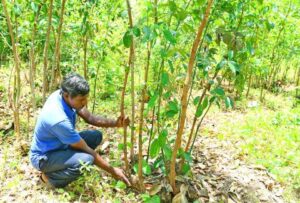Physical Address
23,24,25 & 26, 2nd Floor, Software Technology Park India, Opp: Garware Stadium,MIDC, Chikalthana, Aurangabad, Maharashtra – 431001 India
Physical Address
23,24,25 & 26, 2nd Floor, Software Technology Park India, Opp: Garware Stadium,MIDC, Chikalthana, Aurangabad, Maharashtra – 431001 India

Sri Lanka produces around 80% of the cinnamon used in commercial products worldwide. Cinnamon products are popular, especially in the food and perfumery industries. Although the cinnamon constituents occur naturally, if they exceed the recommended limits of the World Health Organization, they may impose harmful health effects. Therefore, determining the distribution levels of cinnamon constituents in commercial reactors and environmental compartments is important. In the environment, the long-range transport of chemicals can occur due to climatic variations, spreading the effect of the exposed chemical to a broader area. A research team from the University of Peradeniya Sri Lanka, Dr. J. A. Thiloka C. Ariyasena and Mr K. Pradeep Hewage, together with Prof. Colin F. Poole from the USA, were recently able to determine the descriptor values of cinnamon constituents, including cinnamyl acetate, methyl cinnamate and ethyl cinnamate. This technique will reduce the number of trials needed to reach an experimental value reducing the cost and required resources. This is beneficial to developing countries like Sri Lanka, especially in a situation where technical and economic resources are limited.
The summary of the research is included in the below poster.

Let`s see how global climate change is influencing the cinnamon industry.
Climate change is one of the main factors impacting cinnamon cultivation. Because the trees need suitable climatic conditions to grow, these changes influence cinnamon production. Furthermore, climate change intensifies the spread of pests and diseases that can harm cinnamon plants and lower harvests.
Therefore, while this industry seems to be a convenient space with the ability to export as a premium agricultural export, the absence of a national plan and corporate initiative has led the industry not to take root as it best can. More details about it can be read here.
A video about Sri Lanka`s cinnamon industry, prepared by Business Insider in 2021, can be watched below.
Environmental Impact of the Cinnamon Industry
There are concerns about the environmental impacts of cinnamon cultivation also.
There have been significant concerns about the ecological impacts of cinnamon because all the cinnamon trees have to be cut down during the harvesting process, causing deforestation. This concern isn’t totally correct. Because people usually mix up Ceylon cinnamon and Cassia cinnamon, and they do not go into the details of how these two types of cinnamon are produced. These two cinnamons are different species and have different life cycles in harvesting and production.
Unlike Ceylon cinnamon, which is cultivated for spice agriculture and replanted, Cassia is usually a large plant of 20-30-40 or more years old. When cassia trees are cut down because it’s not part of regular agriculture, replanting may or may not happen. When it’s not replanted, it can pave the way to deforestation, eventually intensifying the disastrous effects of global climate change.
To sum up, the concern of deforestation is valid in cassia cinnamon, but not in Ceylon cinnamon, which is spice agriculture.
Generally, only the skin peel of the cassia tree is utilised as ‘cinnamon’. The bark and branches are used as wood. In Ceylon cinnamon, the whole branch and bark are peeled into layers, and almost all part of the tree is used—very little food waste.
In the trade, there are both cassia cinnamon and Ceylon cinnamon with the name ‘cinnamon’. For commercial gains, there might be mixes of these two varieties, too, in some circumstances. More details about it can be found here.